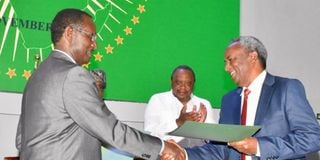TPLF to ‘disarm’ if Eritrean troops leave

Ethiopia’s Chief of the General Staff Field Marshal Birhanu Jula (left) and Lt-Gen Tadese Woreda, the Commander of the Tigray Armed Combatants in Karen, Nairobi, when they signed a disarmament deal. Looking on is former Kenyan President Uhuru Kenyatta (centre) and African Union High Representative for the Horn of Africa, Olusegun Obasanjo (partly hidden).
Ethiopian government on Saturday agreed with commanders of the Tigray Liberation Front (TPLF) fighters to disarm, once Eritrean troops leave the war scene.
A disarmament agreement reached in Nairobi, on the mediation of the African Union negotiators, said the rebel group had accepted to surrender both heavy and light weaponry to help end the war.
But that decision would be pegged on the departure of “foreign forces.”
The Nairobi document titled: Declaration of the Senior Commanders on the Modalities for the Implementation of the Agreement for Lasting Peace Through Permanent Cessation of Hostilities, seeks to ensure an orderly arms surrender for the combatants; but mainly focused on ensuring return to normalcy including unhindered humanitarian access to the troubled Tigray region.
It did not name Eritrean troops by name. However, a clause signed by Field Marshal Birhanu Jula, Ethiopia’s Chief of the General Staff and Lt-Gen Tadese Woreda, the Commander of the Tigray Armed Combatants, says the two sides will only recognise one national defence force in Ethiopia.
“Disarmament of heavy weapons will be done concurrently with the withdrawal of foreign and non-NDF forces from the region,” says Article 2.1 (d) of the agreement on disarmament.
Parties also agreed to “halt and disengage from all forms of military action.”
The TPLF had been fighting the Ethiopian National Defence Forces since November 2 when they signed an agreement on ‘cessation of hostilities.’
The war, however, had attracted other parties, including Eritrea which had an old axe to grind against the TPLF from the time the Ethiopian rebels led their country. It also attracted militias from the neighbouring regional governments of Amhara and Afar, both of which had scores to settle and fought on the side of the ENDF.
The extra parties were not part of negotiations for the peace deal and the TPLF has since accused Eritrean forces of continual crimes even after the peace deal.
Kindeya Gebrehiwot, head of Tigray External Affairs Office said on Friday Eritrean troops were still “Killing, kidnapping and shelling” in areas such as Shire and AdiDaero.
“There is [a] flock of Eritrean civilians including women on a looting mission as spotted today at Shire…after curfew and they do all evil things in darkness,” he claimed.
Eritreans haven’t commented on the peace deal yet.
The deal between commanders now means a return to normalcy will kick off but mediators; African Union High Representative for the Horn of Africa Olusegun Obasanjo and former Kenyan President Uhuru Kenyatta, said the primary duty will be humanitarian supplies to affected civilians.
The Commanders agreed to protect civilians including ensuring their sites are not attacked nor humanitarian convoys blocked from reaching affected populations.
In the deal, military leaders from both sides agreed to, in the next seven days, to give orientation to their soldier about the change of times, including that the war had ended. After that, Ethiopian government authorities will take over their responsibilities in Tigray.
They also agreed to draft a light weapons disarmament based on a decision of a joint committee of two commanders that will also include a representative from the African Union. That plan should be publicised by November 26.
In the meantime, a team of monitors checking violations should swing into action by November 22. It will include representatives from the Ethiopian government, TPLF, the African Union and regional bloc, Intergovernmental Authority on Development.
They also agreed on the “constructive role” of the media, effectively agreeing to tame propaganda or incitement from each side’s media outlets.
The disarmament deal doesn’t say what will happen to combatants of the TPLF once the disarmament is done.
However, it is expected that a more elaborate disbarment programme for light weapons to be published in two weeks will provide details.
The disarmament deal:
- ENDF to protect civilians
- Humanitarian supplies to be unhindered
- Both parties to disengage from military mobilisation
- Foreign fighters to depart at the same time as TPLF disarms heavy weapons
- Disarmament programme to be published in two weeks
- Military chiefs on both sides to conduct orientation of their troops on the peace deal
- Ethiopian government to take charge of services in Tigray





